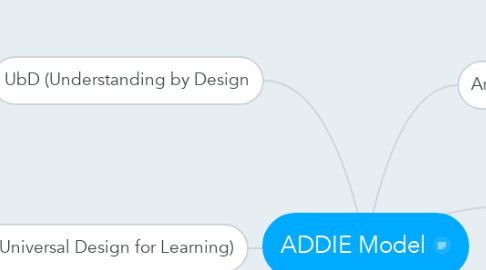
1. Evaluate
1.1. Summative Assesment
1.1.1. An assessment at the end of a unit. Looks to test on the "sum" of information a student gains throughout a unit. Could be related to a TO
1.2. Formative Assessment
1.2.1. Like a mid-way check point. Exists to monitor student performance as a unit progresses. Could be correlated with task-oriented EOs
1.3. Technology Based Assessments
1.3.1. Turning point
1.3.1.1. https://smcminstructionaldesign.pbworks.com/w/file/fetch/82889953/Turning%20Point.pdf
1.3.2. Socrative
1.3.2.1. https://smcminstructionaldesign.pbworks.com/w/file/fetch/83020816/SocrativeUserGuide.pdf
1.3.3. Other technologies exist, but I enjoyed these two the most of all for my personal usage.
2. UbD (Understanding by Design
2.1. how (or why) does (blank)influence (blank)
2.1.1. eq is based on broad concepts and can be answered quite differently based on personal viewpoints and perspectives
2.1.2. part of design
2.1.3. direct, supporting and essential questions
2.1.4. enduring understandings,two or more concepts combine to make a relationships
2.1.5. eduring understanding is written with two concepts and a connecting verb
3. UDL (Universal Design for Learning)
3.1. Differentiation with Learning Menus
3.2. Think handicapped doors. Thinking upfront about how to incorporate everyone into everything. How can I make my materials more accessible for everyone upfront - so it requires less tweaking.
3.2.1. https://smcminstructionaldesign.pbworks.com/w/file/fetch/82647043/www.udlcenter.org_sites_udlcenter.org_files_updateguidelines2_0.pdf
3.2.2. Provide a way for different types of learners in all lessons you give
3.2.3. Write changes in the "differentiation" box
3.3. https://sites.google.com/site/udlguidelinesexamples/
4. Differentiation
4.1. Be sure to take into account students who have special needs in your class. Students who are gifted/talented or have learning difficulties.
4.2. https://www.teachingchannel.org/videos/differentiating-instruction
5. Analysis
5.1. Learner Analysis
5.1.1. Interests
5.1.2. Age
5.1.3. language
5.1.4. background knowledge
5.1.5. favorite subjects
5.1.6. attitude toward my subject
5.1.7. learning style
5.1.8. culture
5.1.9. services
5.1.9.1. accomodations for IEP 504
5.1.9.2. psych, social, or legal
5.1.9.3. FARMS
5.1.10. Demographics
5.2. Context/Resource Analysis
5.2.1. Technology
5.2.2. money
5.2.3. parental involvement
5.2.4. textbooks
5.2.5. physical space
5.2.6. specialists
5.2.7. administration
5.2.8. other teachers
5.2.9. additional services
5.2.10. transportation
5.2.11. geographic opportunities
5.2.12. students
5.2.13. teacher:student ratio
5.3. Work Analysis
5.3.1. self assessing knowledge
5.3.2. standards for education
5.3.3. internet research of your subject
5.3.4. district requirements
5.3.5. curricular materials
5.3.6. existing teachers and their materials
5.3.7. synthesize/weed out/simplify all of the info that is gathererd
5.4. Links
5.4.1. how to analyze
5.4.1.1. http://cehdclass.gmu.edu/ndabbagh/Resources/IDKB/taskanalysis2.htm
5.4.2. overview
5.4.2.1. http://www.hr-guide.com/data/G510.htm
6. Design
6.1. ABCD Model of Lesson Plans
6.1.1. Audience
6.1.1.1. Who is your lesson aimed at?
6.1.2. Behavior
6.1.2.1. Describes learner capability
6.1.2.2. must be measurable
6.1.3. Condition
6.1.3.1. Equipment or tools that must be used in lesson
6.1.4. Degree
6.1.4.1. Standard for acceptable performance
6.2. Levels of Rigor
6.2.1. https://smcminstructionaldesign.pbworks.com/w/file/fetch/82668085/Hess%27s%20Cognitive%20Rigor%20Matrix%20Handout.pdf
6.3. Sequenceing
6.3.1. https://smcminstructionaldesign.pbworks.com/w/file/fetch/82788187/sequencing_performance_objectives.pdf
6.4. Objectives
6.4.1. Terminal Objectives: ideas that must be met at the end of the lesson or unit. The main idea of a lesson/unit or the purpose for doing an activity.
6.4.2. Enabling Objective: mid way points to achieving a TO. Help guide the student(s) to completing the lesson in a way that helps them retain the proper information
7. Develop
7.1. Gagne's 9 Events Style of Lesson Plan
7.1.1. https://smcminstructionaldesign.pbworks.com/w/file/fetch/82668166/Gagnes_Nine_Events_Instruction.pdf
7.1.2. Way of organizing lesson to appropriate hook students in and get the most out of their interaction with the lesson
7.2. Gradual Release of Responsibility
7.2.1. Structure to help wean students off of teacher assistance as a lesson or series of lessons progress
7.2.2. http://www.sjboces.org/doc/Gifted/GradualReleaseResponsibilityJan08.pdf
8. Implement
8.1. Time management is crucial to getting the most out of the minimal time you have the students for.
8.1.1. https://www.teachingchannel.org/videos/improve-transition-time-management
8.2. Getting their attention is important and keeping it is equally as crucial.
8.2.1. https://www.teachingchannel.org/videos/silent-attention-getting-technique
8.3. Videos that Lin suggested
8.3.1. https://www.teachingchannel.org/videos?default=1

